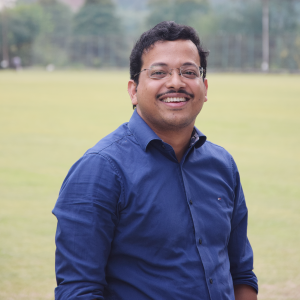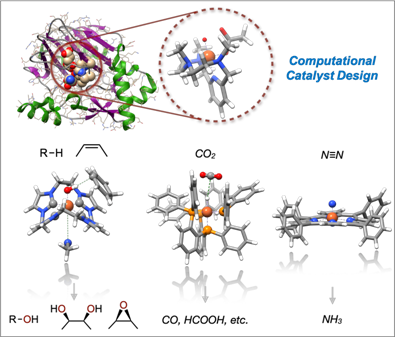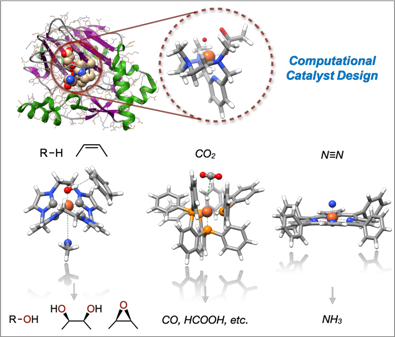Faculty Information

Bhaskar Mondal
Office:
Personal Information
Professional Experience
Assistant Professor, IIT Mandi, (2019-)
Senior Postdoctoral Researcher, RWTH Aachen University, Germany (2017-2019)
Max-Plank Postdoctoral Fellow, Max-Planck Institute for Chemical Energy Conversion, Germany (2013-2017)
EPSRC Postdoctoral Fellow, University of Strathclyde, Glasgow, UK (2011-2013)
Educational Background
Ph.D., Indian Association for the Cultivation of Science (IACS), Kolkata, India, 2007-2011 (With Prof. Abhijit K. Das)
M.Sc. (Physical Chemistry) from University of Calcutta, Kolkata, 2005-2007
B.Sc. (Chemistry) from University of Calcutta, Kolkata, 2002-2005
Broad Area
Computational Quantum Chemistry, Transition Metal Catalysis
Specific Areas
Electronic-Structure Understanding of Small-Molecule (N2, O2, H2O) Activation Catalysis
Mechanistic Understanding of Enzyme Catalysis
Mechanistic Understanding of Photocatalytic Reactions
Atomic-Level Understanding of Biological Systems

CY511: Group Theory and Spectroscopy
CY522: Computational Chemistry
CY513: Reaction Dynamics, Kinetics, and Catalysis
DP501P: Design Practicum-I
IC130P: Chemistry Practicum
UGC-FRP Faculty Recharge Program, UGC India (2015) (not opted)
Finalist for Nanyang Assistant Professorship (NAP), NTU Singapore (2019)
DAAD Research Visit at National Taiwan Normal University, Taipei, Taiwan (2017)
Max-Plank Postdoctoral Fellowship, Max-Planck Society, Germany (2013)
Senior Research Fellowship (SRF) by CSIR, New Delhi, India (2009- 2011).
Junior Research Fellowship (SRF) by CSIR, New Delhi, India (2007-2009).

Bhaskar Mondal
Computational Quantum Chemistry
Transition Metal Catalysis
Catalysis provides the ultimate solution to challenging chemical transformations both in synthetic chemistry (homogeneous/heterogeneous molecular catalysis) and in biology (enzyme catalysis). However, understanding the underlying mechanism and associated electron transfer pathways is often difficult and, thereby, hinders the rational design and development of new systems. Computational methods hold great promises to deliver practical strategies to enable efficient design processes.
Our research focuses on the application of quantum chemical as well as molecular dynamics methods to understand the electronic structure-reactivity correlation aspect of a wide range of catalytic processes. The quantum mechanical (QM) methods, such as density functional theory (DFT), local coupled-cluster methods (DLPNO-CCSD(T)), multiconfigurational SCF (CASSCF), perturbation theory (CASPT2, NEVPT2) are frequently used in our research. In addition, hybrid QM/molecular mechanics (QM/MM) method and Born-Oppenheimer MD (BOMD) are also used in specific cases.
Based on a detailed electronic-level understanding of the molecular reactivity obtained through theoretical calculations, we target in silico design of novel catalytic systems. We also seek to join hands with experimental chemists to develop the rationally designed catalysts.

- M. Bera, K. Keshari, A. Bhardwaj, G. Gupta, B. Mondal*, and S. Paria,* Electrocatalytic Water Oxidation Activity of Molecular Copper Complexes: Effect of Redox-Active Ligands, Inorg. Chem., 2022, 61, 7, 3152.
- Chang, H-C.; Mondal, B.; Fang, H.; Neese, F.; Bill, E.; Ye, S. EPR Signature of Tetragonal Low Spin Iron(V)-Nitrido and -Oxo Complexes Derived from the Electronic Structure Analysis of Heme and Non-Heme Archetypes. J. Am. Chem. Soc. 2019, 141, 2421-2434.
- Mondal, B.; Bill, E.; Neese, F.; Ye, S. Electronic Structure Contributions of Non-Heme Oxo-Iron(V) Complexes to the Reactivity. J. Am. Chem. Soc. 2018, 140, 9531−9544.
- Kupper, C.; Mondal, B.; Serrano-Plana, J.; Klawitter, I.; Neese, F.; Costas, M.; Ye, S.; Meyer, F. Non-ClassicalSingle-State Reactivity of an Oxo-Iron(IV) Complex Confined to Triplet Pathways. J. Am. Chem. Soc. 2017, 139, 8939−8949.
- Mondal, B.; Neese, F.; Ye, S. Toward Rational Design of 3d Transition Metal Catalysts for CO2 Hydrogenation Based on Insights into Hydricity-Controlled Rate-Determining Steps. Inorg. Chem. 2016, 55, 5438-5444.
- 2022
-
- B. Devi, A. Bhardwaj, D. Gambhir, B. Roy, A. Karmakar, G. Dey, A. Jain, B. Mondal*, R. R. Koner*; Cu(II)-Based Coordination Polymer as a Pristine Form Usable Electrocatalyst for Oxygen Reduction Reaction: Experimental Evaluation and Theoretical Insights into Biomimetic Mechanistic Aspects, Inorg. Chem. 2022 (in press).
- M. Bera, K. Keshari, A. Bhardwaj, G. Gupta, B. Mondal*, and S. Paria,* Electrocatalytic Water Oxidation Activity of Molecular Copper Complexes: Effect of Redox-Active Ligands, Inorg. Chem., 2022, 61, 7, 3152.
- 2021
-
- N. Soni, S. Singh, S. Sharma, G. Batra, K. Kaushik, C. Rao, N. C. Verma, B. Mondal*, A. Yadav,* and C. K. Nandi,* Absorption and Emission of Light in Red Emissive Carbon Nanodots, Chem. Sci., 2021, 12, 3615.
- D. Gambhir, B. Mondal*, R. R. Koner*, Molecular-level Insights into Self-Assembly Driven Enantioselective Recognition Process, Chem. Comm., 2021, 57, 2535.
- 2020
-
- L. Roy, B. Mondal, S. Ye, Computational mechanistic insights into non-noble-metal-catalysed CO2 conversion, Dalton Trans. 2020, 49, 16608-16616.
- L. Roy, B. Mondal, F Neese, S Ye; "Theoretical Approach to Homogeneous Catalytic Reduction of CO2: Mechanistic Understanding to Build New Catalysts" in Carbon Dioxide Electrochemistry: Homogeneous and Heterogeneous Catalysis, 2020, Eds. Marc Robert, Cyrille Costentin, Kim Daasbjerg, Chapter 5.
- Mondal, B.; Ye, S. Hidden Ligand Noninnocence: A Combined Spectroscopic and Computational Perspective. Coord. Chem. Rev. 2020, 213115.
- 2019
-
- Agasti, S.; Mondal, B.; Achar, T. K.; Sinha, S. K.; Anjana, S S.; Szabo, K. J.; Schoenebeck, F.; Maiti, D. Orthogonal Selectivity in C–H Olefination: Synthesis of Branched Vinylarene with Unactivated Aliphatic Substitution. ACS Catal. 2019, 9, 9606−9613.
- Chang, H-C.‡; Mondal, B.‡; Fang, H.; Neese, F.; Bill, E.; Ye, S. EPR Signature of Tetragonal Low Spin Iron(V)-Nitrido and -Oxo Complexes Derived from the Electronic Structure Analysis of Heme and Non-Heme Archetypes. J. Am. Chem. Soc. 2019, 141, 2421-2434.
- Roy, L.; Al-Afyouni, M. H.; DeRosha, D. E.; Mondal, B.; Bill, E.; Brennessel, W. W.; Neese, F.; Ye, S.; Holland, P. L. Mechanism of Reduction of CO2 by a Masked Two-Coordinate Cobalt(I) Complex Through an Isolable Oxodicobalt(II) Species. Chem. Sci. 2019, 10, 918-929.
- 2018
-
- Mondal, B.; Neese, F.; Ye, S. “Computational Insights into Chemical Reactivity and Road to Catalyst Design: The Paradigm of CO2 Hydrogenation” in Non-Noble Metal Catalysis: Molecular Approaches and Reactions, Eds. Gebbink, R. J. M. K.; Moret, M‐E, Wiley VCH, 2018, pp. 33-48).
- Mondal, B.; Bill, E.; Neese, F.; Ye, S. Electronic Structure Contributions of Non-Heme Oxo-Iron(V) Complexes to the Reactivity. J. Am. Chem. Soc. 2018, 140, 9531−9544.
